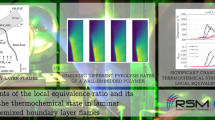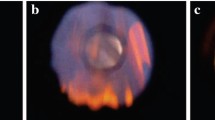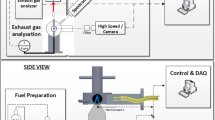Abstract
The relationship between the volumetric heat release rate and radiation of non-premixed hydrogen–oxygen flames at atmospheric and elevated pressure is investigated. Both the radiation of the excited hydroxyl radical (\({\hbox {OH}^*}\)) and the continuous blue radiation are considered. To physically interpret radiation and heat release, the phenomena are first analyzed within laminar flames following a hybrid approach: a pressurized jet flame experiment is set up to correctly measure the \({\hbox {OH}^*}\) and blue radiation. The heat release rate is obtained from a complementary CFD simulation. Radiation and heat release are clearly uncorrelated for changes in pressure. Spatially, radiation and heat release occur at separate locations. To further scrutinize the laminar flame structure, non-premixed counterflow flame simulations are performed. By considering statistical ensembles of flamelets, these findings are transferred onto turbulent flames. As before, no general direct proportionality between radiation and heat release rate is observed because of flame straining. A technique for correcting these effects is applied, and its potential is evaluated. The impact of self-absorption of \({\hbox {OH}^*}\) radiation at elevated pressures on its interpretation is discussed.










Similar content being viewed by others
Notes
The infrared radiation of water vapor and OH is not considered because of its interference with thermal background radiation, self-absorption, and measurement difficulty.
The latter assumption was recently justified numerically by Hossain and Nakamura (2014).
Abbreviations
- a :
-
Strain rate (1/s)
- c :
-
Speed of light (m/s)
- \(c_f\) :
-
Proportionality constant (W/kmol)
- \(g_{m}^{\ominus }\) :
-
Standard-state molar Gibbs energy (J/kmol)
- h :
-
Planck constant (J s)
- \(k_\mathrm{B}\) :
-
Boltzmann constant (J/K)
- L :
-
Radiance (W/m2 sr−1)
- N :
-
Number of flamelets
- p :
-
Pressure (bar)
- \(\dot{q}\) :
-
Volumetric heat release rate (W/m3)
- \(R_m\) :
-
Gas constant (J/kmol K−1)
- T :
-
Temperature (K)
- \(X_{\mathrm{M}}\) :
-
Mole fraction of molecule M
- z :
-
Coordinate (m)
- \(\delta\) :
-
Flame thickness (m)
- \(\lambda\) :
-
Wavelength (m)
- [M]:
-
Concentration of molecule M (kmol/m3)
References
ANSYS (2011) ANSYS FLUENT Theory Guide. ANSYS, INC., release 14.0 edn
Ayoola B, Balachandran R, Frank J, Mastorakos E, Kaminski C (2006) Spatially resolved heat release rate measurements in turbulent premixed flames. Combust Flame 144(1–2):1–16. doi:10.1016/j.combustflame.2005.06.005
Bedard MJ, Sardeshmukh SV, Fuller T, Anderson WE, Tanabe M (2014) Chemiluminescence as a diagnostic in studying combustion instability in a practical combustor. In: 50th AIAA/ASME/SAE/ASEE joint propulsion conference, American Institute of Aeronautics and Astronautics. doi:10.2514/6.2014-3660
Burcat A, Ruscic B (2005) Third millennium ideal gas and condensed phase thermochemical database for combustion with updates from active thermochemical tables. Techinical report, ANL-05/20, Argonne National Laboratory
Burrows MC (1965) Radiation processes related to oxygen–hydrogen combustion at high pressures. Symp Combust 10(1):207–215. doi:10.1016/S0082-0784(65)80165-5 (tenth symposium (international) on combustion)
Burrows MC, Povinelli LA (1962) Emission spectra from high-pressure hydrogen–oxygen combustion. Technical report, NASA-TN-D-1305, NASA Lewis Research Center
Burrows MC, Razner R (1964) Relation of emitted ultraviolet radiation to combustion of hydrogen and oxygen at 20 atmospheres. Technical report, NASA-TN-D-2548, NASA Glenn Research Center
Clark TP, Bittker DA (1954) A study of the radiation from laminar and turbulent open propane-air flames as a function of flame area, equivalence ratio, and fuel flow rate. Technical report, RM E54F29, NASA Lewis Flight Propulsion Laboratory
Daguse T, Croonenbroek T, Rolon JC, Darabiha N, Soufiani A (1996) Study of radiative effects on laminar counterflow H2/O2N2 diffusion flames. Combust Flame 106(3):271–287. doi:10.1016/0010-2180(95)00251-0
Diederichsen J, Wolfhard HG (1956) Spectrographic examination of gaseous flames at high pressure. Proc R Soc Lond A Math Phys Sci 236(1204):89–103. doi:10.1098/rspa.1956.0114
Fiala T (2015) Radiation from high pressure hydrogen–oxygen flames and its use in assessing rocket combustion instability. PhD thesis, Technische Universität München
Fiala T, Sattelmayer T (2013a) Non-premixed counterflow flame simulations: scaling rules for fast batch simulations. In: Proceedings of the European combustion meeting, pp 1–71
Fiala T, Sattelmayer T (2013b) A posteriori computation of OH* radiation from numerical simulations in rocket combustion chambers. In: 5th European conference for aeronautics and space sciences (EUCASS), Munich. doi:10.13140/2.1.1852.0966
Fiala T, Sattelmayer T (2014) Nonpremixed counterflow flames: scaling rules for batch simulations. J Combust. doi:10.1155/2014/484372
Fiala T, Kathan R, Sattelmayer T (2011) Effective stability analysis of liquid rocket combustion chambers: experimental investigation of damped admittances. In: Proceedings of the 62nd international astronautical congress, international astronautical federation, IAC11-C4.3.11. doi:10.13140/2.1.2866.6243
Fiala T, Nettinger M, Rieger F, Kumar A, Sattelmayer T (2014) Emission and absorption measurement in enclosed round jet flames. In: 16th international symposium on flow visualization, Okinawa, Japan, 1138. doi:10.13140/2.1.3424.9609
Gardiner WC, Morinaga K, Ripley DL, Takeyama T (1969) Shock-tube study of oh (sigma–pi) luminescence. Phys Fluids 12(5):I-120–I-124. doi:10.1063/1.1692590
Gaydon AG, Wolfhard HG (1952) The spectrum-line reversal method of measuring flame temperature. Proc Phys Soc Sect A 65(1):19. doi:10.1088/0370-1298/65/1/303
Goodwin DG, Moffat HK, Speth RL (2014) Cantera: an object-oriented software toolkit for chemical kinetics, thermodynamics, and transport processes. http://cantera.org, version 2.2.0
Grcar JF, Day MS, Bell JB (2003) Conditional and opposed reaction path diagrams for the analysis of fluid-chemistry interactions. Report LBNL-52164, Lawrence Berkeley National Laboratory
Gröning S, Oschwald M, Sattelmayer T (2012) Selbst erregte tangentiale Moden in einer Raketenbrennkammer unter repräsentativen Bedingungen. In: Proceedings 61. Deutscher Luft- und Raumfahrtkongress, Berlin, Deutschland
Hardalupas Y, Orain M (2004) Local measurements of the time-dependent heat release rate and equivalence ratio using chemiluminescent emission from a flame. Combust Flame 139(3):188–207. doi:10.1016/j.combustflame.2004.08.003
Hardalupas Y, Panoutsos C, Taylor A (2010) Spatial resolution of a chemiluminescence sensor for local heat-release rate and equivalence ratio measurements in a model gas turbine combustor. Exp Fluids 49(4):883–909. doi:10.1007/s00348-010-0915-z
Hidaka Y, Takahashi S, Kawano H, Suga M, Gardiner WC (1982) Shock-tube measurement of the rate constant for excited hydroxyl(A2.SIGMA.+) formation in the hydrogen–oxygen reaction. J Phys Chem 86(8):1429–1433. doi:10.1021/j100397a043
Hossain A, Nakamura Y (2014) A numerical study on the ability to predict the heat release rate using CH* chemiluminescence in non-sooting counterflow diffusion flames. Combust Flame 161(1):162–172. doi:10.1016/j.combustflame.2013.08.021
Kathrotia T, Fikri M, Bozkurt M, Hartmann M, Riedel U, Schulz C (2010) Study of the H+O+M reaction forming OH*: kinetics of OH* chemiluminescence in hydrogen combustion systems. Combust Flame 157(7):1261–1273. doi:10.1016/j.combustflame.2010.04.003
Kee RJ, Coltrin ME, Glarborg P (2003) Chemically reacting flow. Wiley-Interscience, London
Koike T, Morinaga K (1982) Further studies of the rate constant for chemical excitation of OH in shock waves. Bull Chem Soc Jpn 55(1):52–54. doi:10.1246/bcsj.55.52
Lauer M (2011) Determination of the heat release distribution in turbulent flames by chemiluminescence imaging. Dissertation. Technische Universität München,
Lauer M, Zellhuber M, Aul CJ, Sattelmayer T (2011) Determination of the heat release distribution in turbulent flames by a model based correction of OH* chemiluminescence. In: Proceedings of ASME Turbo Expo 2011, GT2011-45105
Law CK (2006) Combustion physics. Cambridge University Press, Cambridge
Leo MD, Saveliev A, Kennedy LA, Zelepouga SA (2007) OH and CH luminescence in opposed flow methane oxy-flames. Combust Flame 149(4):435–447. doi:10.1016/j.combustflame.2007.01.008
Luque J, Crosley DR (1999) Lifbase 1.9. SRI International
Najm HN, Paul PH, Mueller CJ, Wyckoff PS (1998) On the adequacy of certain experimental observables as measurements of flame burning rate. Combust Flame 113(3):312–332. doi:10.1016/S0010-2180(97)00209-5
Ó Conaire M, Curran HJ, Simmie JM, Pitz WJ, Westbrook CK (2004) A comprehensive modeling study of hydrogen oxidation. Int J Chem Kinet 36(11):603–622. doi:10.1002/kin.20036
Panoutsos C, Hardalupas Y, Taylor A (2009) Numerical evaluation of equivalence ratio measurement using OH* and CH* chemiluminescence in premixed and non-premixed methane-air flames. Combust Flame 156(2):273–291. doi:10.1016/j.combustflame.2008.11.008
Peters N (1984) Laminar diffusion flamelet models in non-premixed turbulent combustion. Prog Energy Combust Sci 10(3):319–339. doi:10.1016/0360-1285(84)90114-X
Peters N (2004) Turbulent combustion. Cambridge University Press, Cambridge
Poinsot T, Veynante D (2005) Theoretical and numerical combustion, 2nd edn. R.T. Edwards, Inc., Philadelphia
Pons L, Darabiha N, Candel S (2007) Pressure effects on non-premixed strained flames. In: Proceedings of the European combustion meeting
Ribert G, Zong N, Yang V, Pons L, Darabiha N, Candel S (2008) Counterflow diffusion flames of general fluids: oxygen/hydrogen mixtures. Combust Flame 154(3):319–330. doi:10.1016/j.combustflame.2008.04.023
Rothman L, Gordon I, Barbe A, Benner D, Bernath P, Birk M, Boudon V, Brown L, Campargue A, Champion JP, Chance K, Coudert L, Dana V, Devi V, Fally S, Flaud JM, Gamache R, Goldman A, Jacquemart D, Kleiner I, Lacome N, Lafferty W, Mandin JY, Massie S, Mikhailenko S, Miller C, Moazzen-Ahmadi N, Naumenko O, Nikitin A, Orphal J, Perevalov V, Perrin A, Predoi-Cross A, Rinsland C, Rotger M, Šimečková M, Smith M, Sung K, Tashkun S, Tennyson J, Toth R, Vandaele A, Auwera JV (2009) The HITRAN 2008 molecular spectroscopic database. J Quant Spectrosc Radiat Transf 110(9–10):533–572. doi:10.1016/j.jqsrt.2009.02.013
Sullivan N, Jensen A, Glarborg P, Day MS, Grcar JF, Bell JB, Pope CJ, Kee RJ (2002) Ammonia conversion and NOx formation in laminar coflowing nonpremixed methane–air flames. Combust Flame 131(3):285–298. doi:10.1016/S0010-2180(02)00413-3
Turns SR (2000) An introduction to combustion: concepts and applications. Mechanical engineering series. McGraw Hill, Boston
Vanpee M, Mainiero R (1979) The spectral distribution of the blue hydrogen flame continuum and its origin in hydrogen–nitric oxide flames. Combust Flame 34:219–230. doi:10.1016/0010-2180(79)90097-X
Wolfhard HG, Parker WG (1952) A spectroscopic investigation into the structure of diffusion flames. Proc Phys Soc Sect A 65(1):2. doi:10.1088/0370-1298/65/1/302
Yang V, Anderson WE (eds) (1995) Liquid rocket engine combustion instability, progress in astronautics and aeronautics, vol 169. AIAA
Yeung P, Girimaji S, Pope S (1990) Straining and scalar dissipation on material surfaces in turbulence: implications for flamelets. Combust Flame 79(3–4):340–365. doi:10.1016/0010-2180(90)90145-H
Yoo SW, Law CK, Tse SD (2002) Chemiluminescent OH* and CH* flame structure and aerodynamic scaling of weakly buoyant, nearly spherical diffusion flames. Proc Combust Inst 29:1663–1670
Acknowledgments
The Deutsche Forschungsgemeinschaft (DFG) in the framework of Sonderforschungsbereich Transregio 40 provided financial support for this project. We thank our project partners M. Oschwald and S. Gröning from DLR Lampoldshausen for helpful discussions.
Author information
Authors and Affiliations
Corresponding author
Ethics declarations
Conflict of interest
The authors declare that they have no conflict of interest.
Rights and permissions
About this article
Cite this article
Fiala, T., Sattelmayer, T. Heat release and UV–Vis radiation in non-premixed hydrogen–oxygen flames. Exp Fluids 56, 144 (2015). https://doi.org/10.1007/s00348-015-2013-8
Received:
Revised:
Accepted:
Published:
DOI: https://doi.org/10.1007/s00348-015-2013-8




